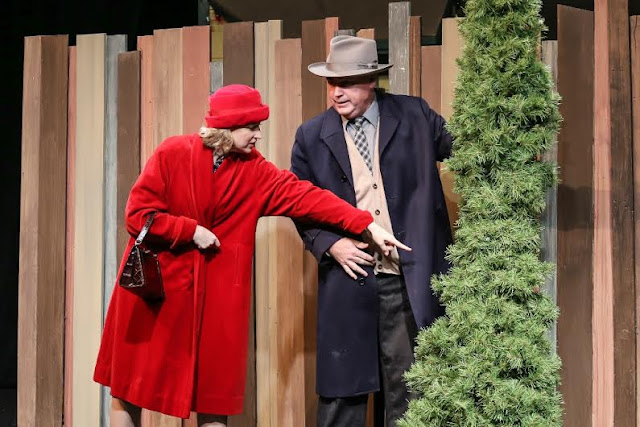A
kinder, gentler Panto
by
Michael Dresdner
Princess Aurora (Sarah Mather) photos by Michelle Smith Lewis
The
traditional English Panto, which Centerstage has been offering lately in the December time slot, is based quite
loosely on a common fairy tale. This time it’s Sleeping Beauty, but only the
barest outline of the story remains. Mostly it is a platform for a clutch of
the traditional Panto conventions; lavish costumes, overblown scenery, plenty
of singing and dancing, a bit of rather obvious magic, general silliness, and
lots of very broad comedy, both verbal and physical.
There’s
also non-stop breaking of the fourth wall, since audience participation is a
must in Panto. Many characters talk directly to the audience, encouraging (hounding?)
them to respond with boos, call and response, chants, and warnings and advice
to certain “clueless” cast members, like King Kevin (Dale Bowers.)
Chief
among the audience warmers, and three of my favorites of all those on stage,
were the good Fairy Moonbeam (Sarah Henley Hicks), her evil rival Carabosse
(Katherine Jett), and the court jester of the stage, Jangles (Josh Williamson),
a particularly and impressively tireless and energetic triple threat actor.
Carabosse (Katherine Jett) and her minions
While former
years have skewed the comedy heavily toward the ribald, this year was quite a
bit more tame. It seemed much more targeted toward a younger audience, and in
fact, opening night was chock full of youngsters who seemed to be enjoying it
no end. The pace was a bit calmer, the jokes safer and clearer, and the whole
presentation more kid-friendly.
While
there were still a few innuendos and inside local digs, most of the non-stop
humor consisted of puns, groaners, and
other word play oddly reminiscent of some iteration of “The Boy’s Big Book of Jokes”
that I owned some 55 years ago. You know; the sort of humor all adults have
heard before, but that is generally deemed hilariously clever by the average
sixth grader.
What
bawdiness remained was delivered almost exclusively by my favorite onstage
character, Nurse Nellie. She follows a Panto tradition of a large and perhaps
unattractive male posing as an older woman who is outrageous, gaudily
overdressed, sarcastic, superior, and blessedly, without restraint. Think Dame
Edna and you’ll be on the right track. As is often the case, the role was
played by the theatre’s own Alan Bryce, and he is consistently brilliant at it.
Rounding
out the cast was the youth and adult ensemble, which contained some very
talented people. Oh yes, and there’s Helga, who is a gigantic but not
particularly dangerous dragon. Hey, this is Disneyesque fare with no death or
serious pain, admittedly a far cry from the tale’s grim Grimm origins.
One
element I missed was the lead boy, normally an attractive young woman dressed
rather provocatively but playing the male romantic lead. This time Prince Peter
was a man (Cooper Harris-Turner), and his task and pleasure was to win Princess
Aurora (Sarah Mather), who becomes sleeping beauty.
Director
Vince Brady called upon the talents of Catherine Cornell for the varied but
exaggerated scenery, Laura Campbell for the almost endless props, Amy Silveria
for lighting and sound design, and Janessa Styck for the wide range of
costumes, including some truly spectacular headgear (and chest gear) on Dame
Bryce. Music director Deborah Armstrong led the onstage band (Andrew Carson,
Kaarin Lysen, Tai Taitano, Cal Neal) superbly, a characteristic that’s become
the norm for these shows.
One
warning, should you decide to take your kids or grandkids: This is a long show.
From curtain to curtain, with one intermission, it ran just ten minutes shy of
three hours. The intermission itself came an hour and forty five minutes after
curtain, so if you’re my age, consider hitting the john before the play
starts.
Sleeping
Beauty
Nov. 28
to Dec. 20, 2015
Centerstage
http://www.centerstagetheatre.com/










































